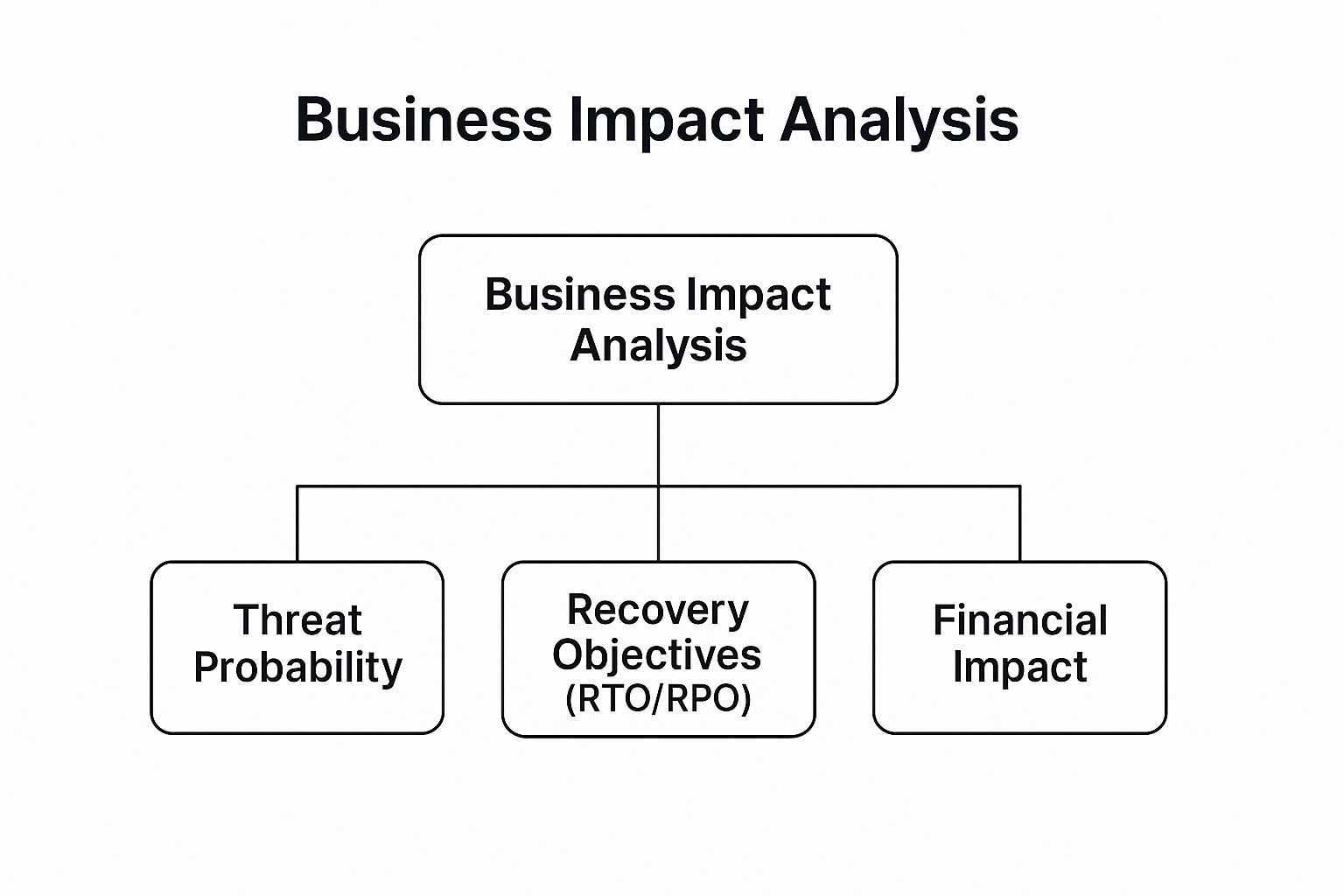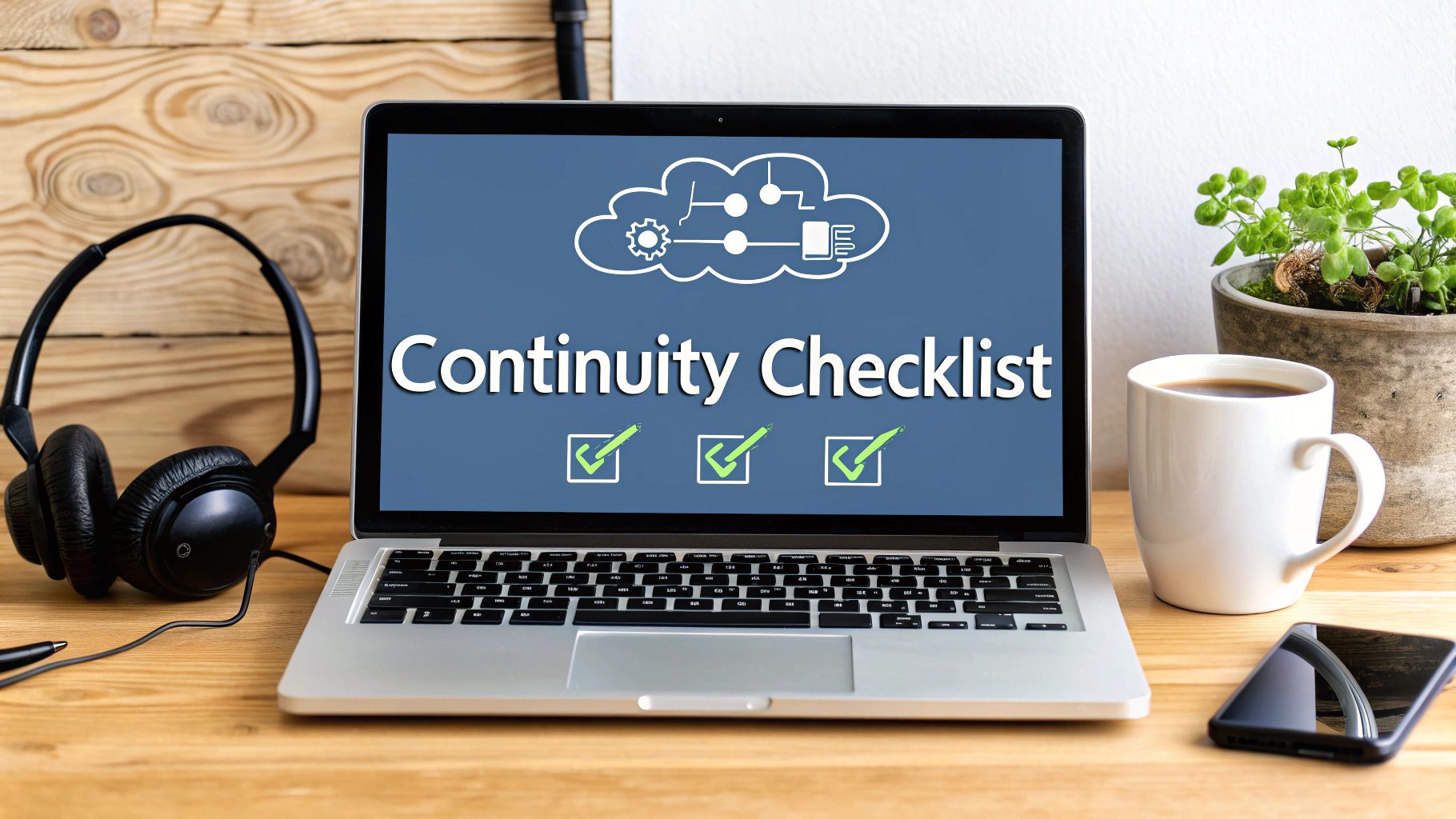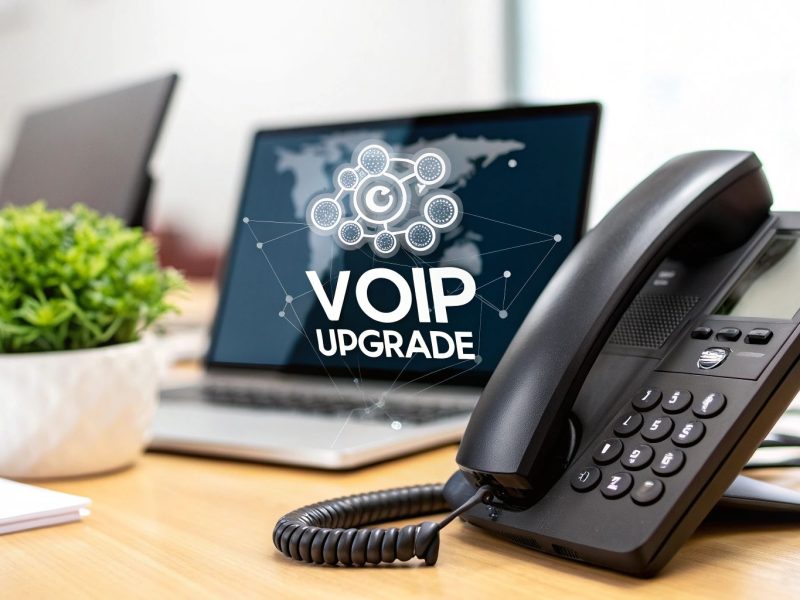Protecting Your Cloud Contact Center: A Continuity Imperative
Cloud contact centers are now essential for business communication. Disruptions, whether from natural disasters or cyberattacks, can severely impact operations, leading to lost revenue and damaged customer relationships. A robust business continuity plan is no longer optional – it's a necessity. This checklist provides eight crucial steps to build a comprehensive plan, specifically tailored for cloud-based contact centers and unified communications. This resource provides actionable strategies for safeguarding your operations and ensuring uninterrupted communication, even during unexpected events.
To safeguard your cloud contact center, it's recommended to begin with a robust foundation, such as this business continuity plan template from Signiance Technologies. This will provide a structure for organizing your plan and ensuring you cover all the essential components.
This business continuity plan checklist helps you:
- Minimize Downtime: Implement proactive measures to reduce service interruptions and maintain customer access.
- Protect Revenue Streams: Avoid financial losses due to communication outages and operational disruptions.
- Maintain Customer Trust: Ensure consistent service and support, preserving customer loyalty and brand reputation.
- Meet Compliance Requirements: Adhere to industry regulations regarding data security and operational resilience.
- Streamline Recovery Efforts: Develop a structured approach to quickly restore normal operations following an incident.
This list provides clear, actionable guidance to build a comprehensive plan. From risk assessment to continuous improvement, each step offers practical insights to strengthen your business continuity strategy.
1. Risk Assessment and Business Impact Analysis (BIA)
A robust business continuity plan checklist must begin with a thorough Risk Assessment and Business Impact Analysis (BIA). This crucial first step identifies potential disruptions to your cloud-based contact center and unified communications, quantifies their potential impact, and prioritizes recovery efforts. Without a BIA, your business continuity plan operates on assumptions, not data. This leaves you vulnerable to unforeseen consequences and potentially crippling downtime. A well-executed BIA provides the foundation for a resilient and effective business continuity strategy.
Understanding the BIA Process
The BIA systematically evaluates all business processes, pinpointing vulnerabilities and dependencies. It's not just about identifying what could go wrong, but also understanding the potential impact of various disruption scenarios. This includes analyzing:
- Financial Impact: Calculate potential revenue loss, recovery costs, regulatory fines, and reputational damage resulting from downtime.
- Operational Impact: Assess the effect of disruptions on customer service, order fulfillment, internal communication, and other key operations.
- Compliance Impact: Identify potential violations of industry regulations and legal requirements due to service disruptions.
When establishing your continuity imperative, consider referencing guides like this one on IT service continuity management. It provides valuable context for building a resilient framework.
Real-World Examples of Effective BIAs
Several high-profile incidents demonstrate the critical importance of a comprehensive BIA:
- JP Morgan Chase: After the 9/11 attacks, their detailed BIA led to new financial sector resilience standards.
- Target: The 2013 data breach prompted a BIA that resulted in a $290 million investment in cybersecurity.
- Toyota: Their supply chain BIA, developed after the 2011 tsunami, enabled faster recovery compared to competitors.
These examples illustrate how a proactive BIA can minimize losses and even improve long-term resilience.

The infographic above visualizes the hierarchical relationship between the core concept of Business Impact Analysis and its key components: Threat Probability, Recovery Objectives, and Financial Impact. These three pillars support the overall BIA process and contribute to a comprehensive understanding of potential disruptions. As the visualization highlights, understanding threat probability in conjunction with financial impact, and aligning these with your recovery objectives, forms the cornerstone of a robust BIA.
Actionable Tips for Conducting a BIA
For a truly effective BIA for your business continuity plan checklist, follow these tips:
- Regular Review: Conduct your BIA annually or after significant business changes, such as mergers, acquisitions, or new product launches.
- Stakeholder Involvement: Engage representatives from all departments to gain a holistic view of potential risks and impacts.
- Data-Driven Analysis: Utilize both historical data and scenario modeling to create realistic impact predictions.
- Documentation: Clearly document all assumptions and methodologies used in the BIA for future reference and updates.
- Interdependencies: Consider cascading effects and interdependencies between different systems and processes.
By following these steps, your BIA will provide the essential data to inform your business continuity plan, enabling faster recovery and minimizing the impact of disruptions on your cloud-based contact center and unified communications environment.
2. Crisis Management Team Structure and Roles
A well-defined crisis management team structure is crucial for effective business continuity, especially for cloud-based contact centers and unified communications. This structure establishes a clear hierarchy of leadership, communication protocols, and decision-making authority during disruptions. It ensures a coordinated response, minimizing downtime and mitigating the impact on your operations. Without a dedicated team with defined roles, your response to a crisis can be chaotic and ineffective, leading to prolonged service interruptions and reputational damage.

Defining Roles and Responsibilities
The crisis management team should include individuals with specific roles and responsibilities. This includes a team leader, communication lead, technical lead, and representatives from key business areas. Each member should have a clear understanding of their duties and the authority to make decisions within their area of expertise. Clearly defined roles prevent confusion and ensure a swift, coordinated response.
Establishing Communication Protocols
Effective communication is essential during a crisis. The team structure must establish clear communication protocols, including designated communication channels, reporting procedures, and contact lists for all team members. This ensures information flows efficiently, enabling informed decision-making and minimizing delays. Consider using a dedicated communication platform for crisis management to streamline information sharing.
Real-World Examples of Effective Crisis Management Teams
Several organizations have demonstrated effective crisis management through well-defined team structures:
- Johnson & Johnson: Their response to the 1982 Tylenol crisis demonstrated effective team coordination and communication, protecting their brand reputation.
- Southwest Airlines: Their handling of the 2016 engine failure incident showcased clear communication protocols and rapid response, minimizing passenger disruption.
- Microsoft: Their COVID-19 response team structure enabled a rapid shift to remote operations for over 150,000 employees, maintaining business continuity.
These examples highlight the importance of a structured approach to crisis management.
Actionable Tips for Building a Crisis Management Team
To build a robust crisis management team for your business continuity plan checklist, consider these tips:
- Dual Roles: Assign both primary and secondary team members for each critical role to ensure coverage in case of unavailability.
- Contact Information: Create detailed contact lists with multiple communication methods (phone, email, SMS) to ensure reachability.
- Regular Training: Conduct regular team meetings and annual crisis simulation exercises to maintain preparedness and test response procedures.
- Decision Support: Develop role-specific quick reference cards and decision trees to guide team members during a crisis.
- Empowerment: Ensure team members have appropriate authority levels for rapid decision-making without unnecessary bureaucratic delays.
By incorporating these elements, your crisis management team will be well-equipped to navigate disruptions, minimizing the impact on your cloud-based contact center and unified communications environment and ensuring continued service delivery.
3. Communication and Notification Procedures
A comprehensive business continuity plan checklist must include robust communication and notification procedures. These protocols are essential for managing internal and external communications during disruptions to your cloud-based contact center and unified communications. Effective communication ensures timely, accurate, and consistent information flow to employees, customers, suppliers, regulators, and other key stakeholders, minimizing confusion and maintaining trust.

Understanding the Importance of Communication Procedures
During a business disruption, communication is paramount. Clear, concise, and frequent updates keep everyone informed about the situation, the recovery process, and any necessary actions they should take. Without established procedures, communication can become fragmented and unreliable, leading to misinformation, anxiety, and reputational damage. Well-defined procedures provide a framework for managing communication effectively during crises, ensuring consistent messaging and minimizing negative impacts.
Real-World Examples of Effective Communication
Several organizations have demonstrated the positive impact of effective communication during disruptions:
- Delta Airlines: During a 2017 system outage, Delta's proactive customer communication via social media and other channels minimized customer dissatisfaction despite widespread flight cancellations.
- Starbucks: Their rapid response communication during the 2018 racial bias incident helped preserve brand reputation by demonstrating a commitment to addressing the issue.
- Zoom: Transparent communication about capacity challenges during the COVID-19 pandemic built customer loyalty by acknowledging the issues and outlining steps to improve service.
These examples highlight how effective communication can mitigate the negative consequences of business disruptions.
Actionable Tips for Establishing Communication Procedures
To build robust communication procedures for your business continuity plan checklist, consider these tips:
- Develop Message Templates: Prepare templates in advance for common disruption scenarios, ensuring consistent messaging and saving valuable time during a crisis.
- Establish Communication Hierarchies: Define clear communication hierarchies with designated spokespersons and approval processes to ensure accurate and authorized information dissemination.
- Test Communication Systems: Regularly test all communication systems, including backup methods, to verify their functionality and reliability during disruptions.
- Train Spokespersons: Provide media training and communication guidance to designated spokespersons to ensure they can effectively communicate with stakeholders during a crisis.
- Monitor Social Media: Actively monitor social media and news channels to identify and address misinformation, maintaining message consistency across all platforms.
By implementing these tips, your organization can establish clear, effective communication procedures that are crucial for mitigating the impact of disruptions on your cloud-based contact center and unified communications environment. This ensures business resilience and maintains stakeholder trust during challenging times.
4. Data Backup and Recovery Systems
A comprehensive business continuity plan checklist must include robust data backup and recovery systems. For cloud-based contact centers and unified communications, this translates to a detailed strategy encompassing automated backups, secure storage, rigorous testing, and data integrity verification. This ensures rapid and accurate restoration of business-critical information after system failures, cyberattacks, or physical disasters. Without a reliable backup and recovery system, your organization risks significant data loss, prolonged downtime, and potentially irreversible damage to operations and reputation.

Understanding Data Backup and Recovery
Data backup and recovery is more than just copying files. It's a holistic process designed to protect your organization's vital information. This includes customer data, call recordings, configurations, and other essential elements of your communication infrastructure. Effective systems must guarantee data availability, integrity, and confidentiality throughout the backup and restoration lifecycle. You might find useful information regarding cloud services and data management relevant to UAE businesses here: Learn more about Azure cloud services in UAE.
Real-World Examples
Several real-world incidents highlight the vital role of robust backup and recovery systems:
- Netflix: Their multi-region backup strategy allowed for minimal disruption during AWS outages, demonstrating the value of geographic redundancy.
- Salesforce: Comprehensive backups prevented significant data loss during their 2019 system failures, allowing for rapid recovery and business continuity.
- Code Spaces: The 2014 cyberattack resulted in complete business failure due to inadequate backup procedures, emphasizing the devastating consequences of neglecting this critical aspect of business continuity.
These examples illustrate the stark contrast between organizations prepared for data loss and those who are not.
Actionable Tips for Effective Data Backup and Recovery
To ensure the effectiveness of your data backup and recovery procedures within your business continuity plan checklist, consider these actionable tips:
- 3-2-1 Rule: Follow the 3-2-1 backup rule: 3 copies of your data, on 2 different media types, with 1 copy stored offsite.
- Regular Testing: Test your recovery procedures at least monthly and meticulously document the results.
- Encryption: Encrypt all backup data, both in transit and at rest, to safeguard against unauthorized access.
- Documentation: Maintain detailed backup and recovery documentation, including procedures, contact information, and storage locations.
- Cloud Solutions: Evaluate cloud-based backup solutions for their scalability, geographic distribution, and disaster recovery capabilities.
By implementing these tips, you can build a robust data backup and recovery system, ensuring the resilience of your cloud-based contact center and unified communications environment. This proactive approach minimizes downtime, protects valuable data, and ultimately safeguards your business's future.
5. Alternative Work Arrangements and Remote Operations
A comprehensive business continuity plan checklist must include alternative work arrangements and remote operations. This framework ensures business operations continue even when primary facilities are unavailable. It encompasses remote work capabilities, alternative site arrangements, mobile technology solutions, and flexible work procedures. This enables organizations, including cloud-based contact centers and unified communications environments, to maintain critical functions regardless of physical location constraints or facility disruptions. Without this, unforeseen events can cripple communication and customer service, leading to significant financial and reputational damage.
Understanding Remote Operations Implementation
Implementing effective remote operations requires a multi-faceted approach. It starts with assessing which roles and functions can be performed remotely. Then, organizations must invest in the necessary infrastructure, including secure remote access technologies, collaboration tools, and communication platforms. Finally, clear policies and procedures must be established to guide remote workers and maintain operational consistency. This is a vital part of any robust business continuity plan checklist.
Real-World Examples of Effective Remote Operations
Several organizations have demonstrated successful implementation of remote work strategies, highlighting their value in maintaining business continuity:
- Twitter: Their early adoption of remote work policies enabled a seamless transition during the COVID-19 pandemic.
- Shopify: Their rapid shift to a distributed workforce during the pandemic maintained business growth despite widespread disruptions.
- IBM: Their long-standing remote work capabilities provided a competitive advantage during various disruptions.
These examples underscore the benefits of incorporating remote operations within a business continuity plan checklist.
Actionable Tips for Establishing Remote Operations
To effectively establish remote operations within your business continuity plan checklist, consider these actionable steps:
- Invest in robust cybersecurity measures: Secure remote access is paramount. Implement multi-factor authentication, VPNs, and endpoint security solutions to protect sensitive data.
- Provide comprehensive training: Equip employees with the skills and knowledge to effectively use remote work tools and procedures.
- Establish clear communication expectations: Define communication channels, response times, and reporting requirements for remote teams.
- Regular testing: Conduct routine tests of remote access systems and procedures to identify and address any vulnerabilities.
- Develop agreements with alternative workspace providers: Secure agreements with co-working spaces or other alternative locations to provide backup workspace if needed. This ensures operational continuity even if individual homes are unavailable.
Why Remote Operations are Essential for Business Continuity
Remote operations are no longer a luxury but a necessity for modern businesses. They provide the flexibility and resilience needed to navigate unforeseen disruptions. By enabling employees to work from anywhere, organizations can maintain critical functions, preserve customer service levels, and mitigate financial losses. This adaptability is crucial in today’s dynamic business environment. Including remote operations within a business continuity plan checklist directly addresses potential disruptions to cloud-based contact center and unified communications, ensuring continued communication and customer service. By following these steps, your business continuity plan will be well-equipped to handle unexpected events and maintain operations regardless of location.
6. Supply Chain and Vendor Continuity Management
A robust business continuity plan checklist must address potential disruptions not only within your organization but also across your extended network. Supply Chain and Vendor Continuity Management is a strategic approach to ensuring your critical suppliers and vendors can maintain service delivery during unforeseen events. This proactive approach reduces dependency risks and ensures continued access to essential goods and services, allowing your cloud-based contact center and unified communications platform to remain operational. Ignoring this aspect can leave your business vulnerable to disruptions originating outside your direct control.
Understanding Supply Chain and Vendor Continuity
Supply Chain and Vendor Continuity Management involves identifying critical suppliers, assessing their resilience, and establishing mitigation strategies to minimize the impact of potential disruptions. This includes supplier risk assessments, alternative vendor identification, contract provisions for business continuity, and supplier monitoring systems. It's not enough to assume your vendors have their own plans; you need to verify and integrate their resilience into your overall strategy. Learn more about optimizing your contact center strategy in our article on omnichannel contact centers.
Real-World Examples of Effective Vendor Continuity Management
Several companies have successfully implemented vendor continuity management, demonstrating its critical importance:
- Apple: Their supplier diversification strategy minimized the impact of COVID-19 manufacturing disruptions, ensuring product availability.
- Toyota: Their supplier development program, emphasizing business continuity preparedness, enabled rapid recovery after the 2011 tsunami.
- Ericsson: Conversely, their single-supplier dependency for a critical component led to a $400 million loss after a 2000 facility fire, highlighting the risks of inadequate vendor management.
These examples illustrate how a proactive approach to vendor continuity can mitigate substantial losses and maintain operational resilience.
Actionable Tips for Managing Vendor Continuity
For effective Supply Chain and Vendor Continuity Management within your business continuity plan checklist, follow these tips:
- Multiple Suppliers: Maintain relationships with multiple suppliers for critical components and services to avoid single points of failure.
- Contractual Obligations: Include specific business continuity requirements in all vendor contracts, ensuring alignment and accountability.
- Regular Assessments: Conduct regular supplier business continuity assessments to evaluate their preparedness and identify potential weaknesses.
- Performance Metrics: Develop supplier scorecards that incorporate resilience metrics, such as recovery time objectives and communication protocols.
- Diversification: Consider geographic and economic diversification in your supplier selection to minimize the impact of regional disruptions.
By implementing these strategies, you can strengthen your supply chain resilience, minimize disruptions, and ensure the continued operation of your cloud-based contact center and unified communications environment.
7. Training, Testing, and Exercise Programs
A comprehensive business continuity plan checklist must include robust training, testing, and exercise programs. These activities are crucial for validating the effectiveness of your plan, identifying gaps, and ensuring your team is prepared to execute it when a disruption occurs. For cloud-based contact centers and unified communications, this translates to maintaining service availability and minimizing customer impact during unforeseen events. Without regular practice, even the most well-designed plan can fail during a real crisis.
Understanding the Importance of Training and Testing
Regular training ensures that all personnel understand their roles and responsibilities within the business continuity plan. Testing, which includes various types of exercises, validates the plan's procedures and identifies areas for improvement. This proactive approach builds team competency and organizational readiness, ultimately minimizing downtime and maximizing resilience. A consistent training and testing cycle ensures your cloud-based contact center and unified communications remain functional even during disruptions.
Real-World Examples of Effective Programs
Several organizations demonstrate the value of robust training and testing programs:
- JPMorgan Chase: Their annual disaster recovery exercises, involving thousands of employees, ensure their systems and processes can withstand significant disruptions.
- Amazon: Their 'Chaos Engineering' approach involves intentionally injecting failures into their systems to test resilience and identify vulnerabilities.
- Singapore: National business continuity exercises involve both government and private sectors, promoting a coordinated response to large-scale emergencies.
These examples showcase how proactive testing and training contribute to organizational resilience.
Actionable Tips for Implementing Effective Programs
To maximize the effectiveness of your training, testing, and exercise programs for your business continuity plan checklist, consider these tips:
- Varied Exercises: Conduct different types of exercises throughout the year, including tabletop discussions, simulations, and full-scale drills, to address various scenarios.
- Stakeholder Inclusion: Involve external stakeholders and partners in relevant exercises to ensure a coordinated response.
- Documentation and Improvement: Document lessons learned during each exercise and implement improvements promptly.
- Realistic Scenarios: Base exercise scenarios on actual risk assessments and potential disruptions to your cloud-based systems.
- Performance Measurement: Track exercise performance metrics over time to identify trends and measure progress.
Learn more about optimizing your contact center operations with effective KPIs at contact center KPIs.
By consistently applying these tips, you can strengthen your business continuity plan, ensuring your cloud-based contact center and unified communications environment remains operational and resilient. This proactive approach safeguards your business against potential disruptions and maintains customer satisfaction even in challenging circumstances.
8. Plan Maintenance and Continuous Improvement
A business continuity plan checklist isn't a "set it and forget it" task. It requires ongoing maintenance and continuous improvement to remain effective. This crucial step ensures your cloud-based contact center and unified communications strategy can adapt to evolving threats, changing business needs, and technological advancements. Without regular review and updates, your plan can quickly become obsolete, leaving your organization vulnerable in a crisis.
The Importance of a Dynamic Approach
The business landscape is constantly changing. New technologies emerge, regulations evolve, and unforeseen events disrupt operations. A static business continuity plan can't effectively address these dynamic challenges. Continuous improvement ensures your plan remains relevant and capable of protecting your business from evolving threats. This proactive approach minimizes downtime, protects revenue streams, and maintains customer trust.
Real-World Examples of Continuous Improvement
Several organizations have successfully implemented continuous improvement within their business continuity planning:
- Microsoft: Their ongoing plan refinement allowed them to adapt quickly to the pandemic, enabling remote work for a vast workforce.
- Wells Fargo: After experiencing operational risk events, Wells Fargo updated their plans to address identified vulnerabilities and enhance future resilience.
- Southwest Airlines: They iteratively improved their business continuity plans after weather-related disruptions, optimizing their response to similar future incidents.
These examples demonstrate the tangible benefits of adapting plans to address real-world challenges.
Actionable Tips for Maintaining and Improving Your Plan
For a truly effective business continuity plan checklist, implement these continuous improvement strategies:
- Establish Formal Review Schedules: Tie plan reviews to business planning cycles, ensuring alignment with strategic objectives and operational changes.
- Create Change Control Processes: Implement formal procedures for documenting and approving plan modifications, ensuring consistency and accuracy.
- Track and Trend Performance Metrics: Monitor key performance indicators related to recovery times, system availability, and customer satisfaction to identify areas for improvement.
- Conduct Annual Comprehensive Plan Reviews: Engage all stakeholders in a thorough review of the entire plan, validating assumptions and confirming alignment with current business needs.
- Maintain Version Control and Documentation: Keep meticulous records of all plan versions and changes, providing a clear audit trail and facilitating future updates.
By actively maintaining and continuously improving your business continuity plan, you ensure its effectiveness in protecting your cloud-based contact center and unified communications environment from disruptions. This proactive approach strengthens your organization's resilience and safeguards its long-term success.
Business Continuity Plan Checklist Comparison
| Item | Implementation Complexity 🔄 | Resource Requirements ⚡ | Expected Outcomes 📊 | Ideal Use Cases | Key Advantages ⭐ / 💡 |
|---|---|---|---|---|---|
| Risk Assessment and Business Impact Analysis (BIA) | High – requires detailed analysis and data collection | High – cross-departmental involvement and updates needed | Data-driven prioritization of critical functions and risks | Foundation for all continuity planning | Provides solid evidence for decisions; supports compliance 💡 |
| Crisis Management Team Structure and Roles | Moderate – organizational design and role definition | Moderate – ongoing training and team upkeep | Clear leadership and rapid, coordinated crisis response | High-stress disruption scenarios | Eliminates confusion; supports accountability ⭐ |
| Communication and Notification Procedures | Moderate – establishing protocols and multi-channel systems | Moderate – technology and maintenance needed | Timely, accurate, and consistent stakeholder communication | Maintaining stakeholder trust during crisis | Reduces misinformation; supports brand reputation ⭐ |
| Data Backup and Recovery Systems | High – technical setups, encryption, and testing required | High – storage, software, and maintenance costs | Minimized data loss and rapid data/system recovery | Protection against data-related incidents | Ensures business continuity; regulatory compliance 💡 |
| Alternative Work Arrangements and Remote Operations | High – infrastructure and security for remote work | High – technology investment and management | Continued operation regardless of physical location constraints | Facility outage or location disruption | Enhances workforce flexibility and resilience ⭐ |
| Supply Chain and Vendor Continuity Management | Moderate to High – supplier assessments and contract management | Moderate to High – monitoring, alternate sourcing | Reduced supply chain disruption and diversified supplier base | Critical supplier dependency management | Reduces single points of failure; improves resilience ⭐ |
| Training, Testing, and Exercise Programs | High – repeated training and realistic simulations | High – time, personnel involvement, and planning | Validated plans, competent teams, improved emergency response | Plan validation and readiness maintenance | Builds confidence; identifies gaps; supports audits ⭐ |
| Plan Maintenance and Continuous Improvement | Moderate – ongoing review and updates | Moderate – resource allocation for monitoring and changes | Current, relevant, and effective plans adapted to evolving risks | Long-term plan sustainability and compliance | Ensures continuous alignment with business needs ⭐ |
Fortifying Your Future: Implementing Your Business Continuity Plan
This business continuity plan checklist provides a comprehensive framework for navigating disruptions, minimizing downtime, and safeguarding your operations, particularly crucial for cloud-based contact centers and unified communications environments. From assessing risks and structuring your crisis management team to implementing robust data backup systems and ensuring vendor continuity, each step contributes to a resilient organizational posture. Mastering these eight key components will empower your organization to not just survive disruptions but to thrive in the face of adversity.
Key Takeaways and Actionable Next Steps
Let's recap the most crucial elements of a robust business continuity plan and outline the steps you should take to implement them effectively:
- Prioritize Risk Assessment: Conduct a thorough Business Impact Analysis (BIA) to identify your organization's most critical processes and the potential consequences of disruption. This forms the foundation of your entire BCP.
- Establish Clear Communication Channels: Define communication protocols and notification procedures to ensure timely and accurate information flow during a crisis. This includes internal communication within your team and external communication with customers and stakeholders.
- Embrace Cloud Solutions: Leverage the flexibility and scalability of cloud-based contact center solutions to maintain operational continuity in the face of unforeseen challenges. Consider implementing remote work capabilities for your agents.
- Test and Refine Regularly: A business continuity plan is a living document. Regular testing and exercises are essential to identify weaknesses, refine procedures, and ensure your plan remains effective.
Maintaining Your Business Continuity Plan
Maintaining your BCP is as crucial as its initial creation. Regularly review and update your plan to reflect changes in your business environment, technology, and regulatory landscape. Consider establishing a dedicated team responsible for plan maintenance and continuous improvement. Even seemingly minor details, such as ensuring HVAC systems are functioning correctly in your alternate work location, can significantly impact operations. For a detailed maintenance checklist for HVAC service companies, consider referencing this article from My AI Front Desk. Integrating these details into your BCP ensures comprehensive preparedness.
The Value of Business Continuity in the AE Region
In today's interconnected world, businesses in the AE region face a complex and evolving threat landscape. From natural disasters to cyberattacks, organizations must be prepared for a wide range of potential disruptions. A robust business continuity plan is not just a best practice; it's a strategic imperative. By prioritizing business continuity, organizations can demonstrate their commitment to resilience, protect their reputation, and maintain the trust of their customers and partners.
Investing in a comprehensive business continuity plan, tailored to your specific needs and environment, is an investment in your organization's future. It provides a roadmap for navigating uncertainty and ensuring your business can weather any storm. The proactive steps you take today will pave the way for sustained success tomorrow.
Ready to strengthen your organization's resilience and ensure business continuity? Cloud Move provides specialized cloud-based contact center and unified communications solutions designed for scalability, security, and reliability. Visit Cloud Move to explore how we can help you build a future-proof communication strategy.




